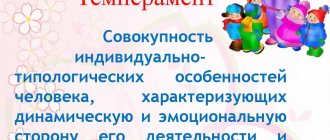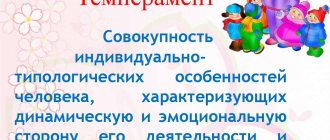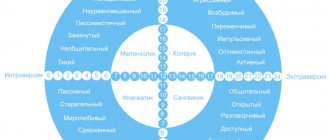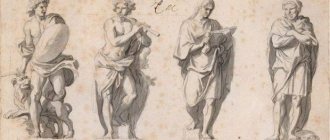Temperament is a stable set of individual mental characteristics, which is based on the type of higher nervous activity of a person. Forms the basis for the development of character traits.
Scientists have tried to determine the type of temperament from ancient times to the present day. The experimental psychologist G. Eysenck's Personality Inventory (EPI) is a classic technique proposed in 1963 based on his two previous tests. The theoretical basis is formed by the concepts of “extraversion”, “introversion” and “neuroticism”, which the author understood as genetically determined characteristics of the central nervous system.
This test is still popular today - due to its simple instructions, accessible processing and the ability to take it online on the Internet quickly and for free.
Hans Jurgen Eysenck is a world-famous scientist who created a test to determine human intelligence quotient - IQ, which is constantly used today.
Predecessor tests
The first temperament questionnaire, the MMQ, was introduced in 1947. It used a single scale as a diagnostic - “neuroticism”. It contained 40 statements with which the person agreed or disagreed. In the course of further research on large samples, the scientist determined that the answers given to the questions of this questionnaire made it possible to identify another measurement scale - “extraversion-introversion”.
Nine years after the first test was published, Eysenck proposed a second personality questionnaire, the MPI, consisting of 48 questions.
During the studies, discrepancies were revealed between the author’s theoretical statements and the data, so scientists and collaborators continued to search for new possibilities that would allow them to determine the type of temperament in accordance with the proposed scales - “neuroticism”, “extraversion and introversion”.
How to determine the temperament of a woman or man by appearance
The type of temperament is often clearly characterized by external signs. So, for example, a caricatured melancholic is thin, tall, with an elongated and sad face.
This is how the famous artist H. Bidstrup described the external features of the various types:
More details about each type:
- Sanguine people have round shapes and may be overweight. Medium or short height. The gait is relaxed, swaggering. The face is round or heart-shaped, the nose is most often bulbous or slightly upturned. Cheekbones are not pronounced.
- Phlegmatic people are slow, recognized by their measured, unhurried gait. Although they have a strong physique, they are also prone to obesity. The body is firmly built, barrel-shaped, tall. Facial features rarely have sharp and memorable shapes.
- Cholerics are easy to recognize: they are thin people with pointed facial features. Their movements are energetic and fast. The nose is clearly defined, often with a hump.
- Melancholic people are pale, thin, and have a sickly appearance. The lips are thin, the corners of the mouth are downturned, which gives the face an expression of deep sadness.
Don't make hasty conclusions based on a person's appearance: it can often be deceiving. Only a psychologist can accurately determine a person’s temperament.
Improved techniques
In 1963, the EPI (Eysenck Personality Inventory) questionnaire was proposed - a new technique, the questions of which, in the amount of 48 pieces, are intended to diagnose the “neuroticism” and “extraversion-introversion” scales, and 9 add up to the “lie” scale - with its help it is determined a person’s desire to “embellish” himself (a total of 57 points were identified).
The EPI methodology was developed based on responses received from more than 30 thousand people, which is several orders of magnitude greater than the number that was involved in the creation of MMQ and MPI.
The test uses two versions with different questions, but identical in form and meaning (to be used twice).
Six years later, Hans and Sibylle Eysenck offer the EPQ, a personality questionnaire that diagnoses not only the previous two described scales and the “lie” scale, but also psychoticism. Its high level is associated with the severity of special conditions in which the presence of inadequate mental reactions (psychosis) is possible. The test involves passing 101 questions.
The name of Eysenck is also known due to the fact that he proposed a method for identifying self-assessment of mental states, during which the presence of a prevailing psychotype is determined - frustration, anxiety, aggressiveness and rigidity.
Currently, the EPQ is not very popular, and not only because the previous test includes 57 questions - almost half as many as the present one. Many foreign researchers argue that the psychoticism scale cannot have a scientific basis, and the results obtained during experiments are often contradictory.
Sanguines
Sanguine people are energetic and friendly, welcoming and sociable; with any person they will always have a topic to talk about. They say about such people: “They don’t mince words.”
Any event that attracts the attention of a sanguine person evokes a lively response from him: he either laughs at the slightest reason or just as sincerely gets angry for some insignificant reason. The facial expressions and gestures of a sanguine person are bright and expressive - from them you can easily determine his mood. But if he wants, he can completely control his feelings and not show them.
Sanguine people are optimists, they are carefree and joyful, they live in the present, do not remember past failures and do not think about the future. They are active and efficient, they are alien to routine and monotony, they crave new bright impressions.
But sanguine people are often fickle, disorganized and have a tendency to use other people, make promises and not keep them. They easily admit their guilt and just as easily find excuses for themselves and ask for forgiveness, but they continue to behave as before. They can be on their own and impose their point of view; they like to dominate.
Description of scales
The “neuroticism” scale describes a certain personal aspect of mental self-regulation. It is based on the concept of emotional stability, which is expressed by adaptive capabilities in everyday and stressful situations, the absence of severe anxiety, vegetative neurosis-like states, and self-doubt. High scores on this scale do not necessarily indicate that a person has neurosis, but they allow it to develop in the presence of prolonged stressful situations. A person in whom this technique allows us to determine a high level of neuroticism will most likely be emotionally unstable, impulsive, lacking self-confidence, irritability, and prone to excessive impressionability and sensitivity. His reactions will not be adequate to the situations that caused them.
Extraversion is a trait that involves focusing on people around you and interacting with them. A typical extrovert is sociable, impulsive, full of optimism, prefers to move forward, and is prone to risk.
Introversion is characteristic of people who are self-absorbed, reserved, and keep a distance from others (with the exception of close people). An introvert does not like to take risks and tries to take a thoughtful approach to making decisions. Keeps impulses under control and is pessimistic.
Eysenck determined that a high score on the “neuroticism” scale is associated with a decrease in the threshold of activation of the limbic system, and “extraversion-introversion” – of the reticular formation.
Interpretation of results uses psychological characteristics located in a coordinate system (the EPQ test uses a three-dimensional scheme, which also includes the “psychoticism” scale). The degree of expression of a particular property is considered. The author believed that the strong and weak types identified by I.P. Pavlov, are close in description to extroverted and introverted. Taking this into account, the classic types of temperament are determined: sanguine (stable and extroverted), phlegmatic (stable and introverted), melancholic (unstable and introverted), choleric (unstable and extroverted).
Thus, the present EPI technique, which allows you to determine the type of temperament, is accessible and easy to determine and interpret the results.
general information
It is impossible to meet two completely identical people with identical characters. Some individuals are calm and slow, others are noisy and active. These differences represent external manifestations of personality traits. At the same time, you need to understand that no one is born with a formed personality. The formation of character is observed throughout his life, under the influence of society. In early childhood, only fundamental qualities and emotionality are present.
A person’s temperament is his individuality, expressed by behavioral characteristics, the speed of mental processes and various responses to events.
You can find out the temperament of a certain individual by carefully observing him, his external manifestations, and also by assessing his responses to various life situations.
Today there are many methods. A person who wants to determine the typology of his temperament answers special questions. They are elementary and affect the personal qualities of the individual. It is important that the subject answers with maximum accuracy and quickly, and does not waste time thinking about each question. There is no need to be afraid that the wrong answer will be given. To find out what type you have, you need to behave naturally and not embellish reality.
Perhaps you don’t understand why you need to find out your temperament type. In fact, this allows a person to determine the presence of weaknesses and strengths and adjust their behavior. Also, this knowledge helps to correctly relate to the people who surround a person, taking into account the characteristics of their character. Parents, knowing that their child is phlegmatic, will not demand that he quickly complete work or some task. Also, having an idea of who is next to you helps in your personal life and allows you to avoid many conflicts and scandals.
Choleric woman
A choleric woman is powerful, emotional, purposeful and businesslike. She strives to dominate both in the family and at work. Peace and harmony in marriage are possible only if the husband of such a woman is gentle and non-conflict. He will have to recognize his wife's leadership and come to terms with her claims to power.
Business qualities and organizational skills allow a choleric woman to quickly move up the career ladder and earn a lot. She can easily feed the whole family on her own. At work she is valued and respected, but she can have intrigues behind her back.
Such a woman’s wardrobe is dominated by trousers and jackets; she avoids deliberately feminine outfits and bright jewelry. Convenience and practicality are more important to her than beauty.
Temperament: analysis of the main types
Choleric
These are mobile, often uncontrollable and even unbalanced people who have a thirst for activity. They cannot sit in one place, they need a change of activity.
A choleric person is a workaholic, he works with complete dedication, but reacts violently and hysterically to failures. Often takes on many tasks without completing the rest.
pros
Among the important advantages of this temperament, the following features are noted.
- Mobility and activity.
- Quick reaction and good learning ability.
- Directness and determination, especially in the field of science, work, study.
- Violent reaction to criticism, but quick response. Such people do not hold grudges for long and forgive quickly.
- In a dispute, he is resourceful, constantly strives for something new, and is ready to learn almost all his life.
- Ability to make quick decisions.
- Emotionality and excellent facial expressions. Often it is the choleric person who becomes a good speaker, capable of raising the masses and preaching various ideas.
- A quick “ignition” of feelings, but which die out just as quickly.
Cholerics do not complain about lack of sleep. They fall asleep quickly, wake up just as quickly, and sleep soundly. This is a special character trait.
Minuses
Among the negative aspects there are such features.
- Risk-taking and haste.
- Lack of patience and loss of interest in endeavors; for a long time a person is unable to concentrate on one thing.
- Aggressiveness and hot temper, poor reaction to criticism, even fair ones.
- Impetuosity and harshness in statements.
- Stubbornness and whims.
- Mood changes and nervous breakdowns.
- Impatience with other people's shortcomings, mistakes and failures.
You should not look for all these traits in one person. Psychology takes an individual approach to determining temperament. It often happens that in one person the traits and properties of different temperaments are intertwined.
A choleric person is able to quickly react to various life situations, he is ready to make decisions with lightning speed, and often devotes all his strength to a cause in which he believes. This leads to emotional emptiness and poor health. Conflicts with people may also occur, but one should not forget that a choleric person is an easygoing person, and therefore he will not be angry or offended for a long time.
Sanguine
He is a reliable and reliable person with a calm, easy-going, and often cheerful disposition. Moreover, the nervous system of such a person is often mobile, and his actions are deliberate. A cheerful sanguine person easily and simply endures the hardships of life, solves problems as they arise, does not panic and is not eager to fight. He must think everything over carefully in order to make the only right decision.
pros
Among the character advantages of a sanguine person are the following traits.
- Sociability and cheerfulness.
- Constantly fueled interest in different aspects of life.
- High degree of affection and devotion.
- An easy attitude towards losses and failures.
- Quick adaptation to new conditions.
- Fast learner.
- The opportunity to quickly join a new team and find friends there.
- Lack of despondency even in difficult life circumstances.
- The presence of enthusiasm in a new business.
- The presence of fortitude and determination.
A sanguine person is a largely positive person who does not cause trouble to others, he becomes a support. Cheerfulness can captivate many, and therefore a sanguine person often becomes the life of the party. This also happens because this person is a good organizer.
Minuses
Among the negative qualities there are such shortcomings.
- Lack of perseverance, especially if you have to do tedious work.
- Tendency to overestimate one's own strengths.
- Mood instability.
- The possibility of making a mistake due to an easy nature and not fully thought-out decisions.
- Difficulty in developing strong-willed qualities.
- Lack of accuracy and determination.
However, a sanguine person easily turns even his negative character traits into positive ones. He has the drive to overcome himself if he wants to.
Phlegmatic person
Among the main qualities of such a person is inertia, which often seems to others to be a manifestation of callousness and indifference. A phlegmatic person is not ready to talk for a long time, to have conversations on various topics - long-term communication is a burden for him, he tries to retire away from the bustle and noise.
A phlegmatic person has increased efficiency; he will cope with those tasks in which choleric and sanguine people will not succeed. Under any circumstances, he remains calm, which is not always clear and acceptable to the people around him.
pros
Among the advantages of a phlegmatic character are the following traits.
- Calmness in the most difficult life situations.
- Diligence and stress resistance.
- Consistency and thoroughness in actions.
- Perseverance and perseverance, which is especially important for achieving important goals.
- Ability to perform tedious, boring, and often difficult work. This quality is preserved even in cases where the task is complex and the processes are monotonous.
- Lack of inclination to affect: impulsiveness and acting under the influence of feelings are not about phlegmatic people.
- Systematicity in work.
- No excessive talkativeness.
A phlegmatic person is a person for whom it will be easy and simple to comply with any work schedule or regime. It has excellent endurance.
Minuses
Among the disadvantages of this temperament are the following features.
- Inability to take criticism. It is useless to scold and criticize such a person.
- Stubbornness. Although the phlegmatic is an excellent worker, he is still famous for his tediousness.
- Stinginess with emotions, which is why loved ones often suffer.
- Weak response to stimuli.
- Slow adaptation to new circumstances.
- Constantly following the stereotypes and patterns established for oneself or by society.
- Lack of ingenuity and resourcefulness.
There is an opinion that phlegmatic people are diligent “bees”, but not inventors and engines of progress.
Melancholic
This is an unbalanced psychotype who is quite sensitive to criticism and changes in circumstances. A melancholic person tends to find negative information for himself even in insignificant facts. Increased sensitivity negatively affects performance, stress tolerance leads to the need for long rest.
Even a minor reason can cause long-term resentment and cause for tears.
pros
The advantages of this character include the following traits.
- Sensitivity, which affects intellectual and artistic qualities. There are a great many creators among melancholic people.
- High demands placed on yourself.
- Excellent understanding of the feelings and desires of loved ones and relatives.
- Restraint and tact, but these qualities will have to be developed in a melancholic person.
- Depth of thought and consistency. Among such people there are many thinkers and philosophers.
Minuses
Among the disadvantages are the following features.
- Excessive emotionality, touchiness.
- Pessimism.
- Rare manifestations of good mood, which negatively affects people's attitudes.
- Tearfulness and difficult adaptation to a new team.
- Difficulty in coping with even rare failures.
- Minimum circle of close people.
Melancholic people should develop positive character traits, spend more time in public, and remain immune to the words of strangers.
Phlegmatic people
If among your friends there is a balanced person who has an analytical mind, then most likely he is a phlegmatic person. This guy is pretty lazy. He doesn't like to fuss, preferring to just go with the flow. He thinks through all his steps in advance and is not considered an impulsive person.
The phlegmatic person is stingy with emotions. It is difficult for him to show feelings of joy and pain. They won't shed a tear. Their emotional state resembles a scale. They are able to withstand heavy loads. This type of person is not the first to make contact. They find change difficult. If they have to change something suddenly, they feel disorientated for a while.
They are hard workers at work. It is not difficult for them to do monotonous work. Phlegmatic people are ready to understand the problem, analyze and remember a large amount of information.
This type of people is hidden and reserved. It is difficult for them to find new friends and be the first to show interest in the opposite sex. If he really likes someone, he will do everything to achieve their favor. Phlegmatic people start a family late. For them, this is a responsible step, so it takes them a long time to make a choice.
Disadvantages of the type:
- poorly adapt to changes;
- are not the first to make contact;
- show emotions sparingly.
- are slowly starting to work.
Advice
:
A recommendation for a phlegmatic person is to fight his laziness and isolation.









